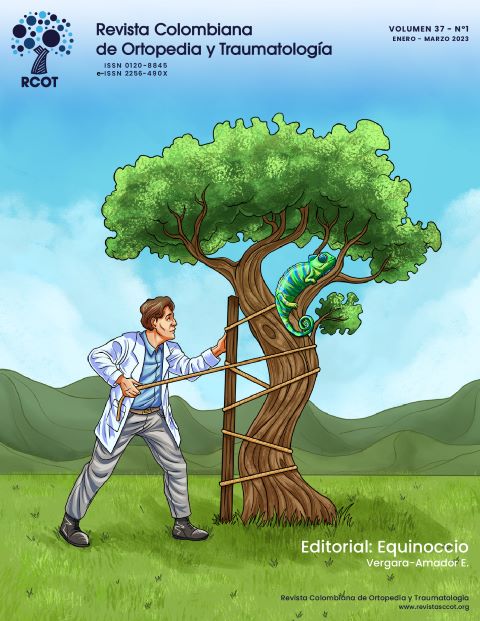Coxa vara surgery for osteogenesis imperfecta. A report of two cases
DOI:
https://doi.org/10.58814/01208845.9Keywords:
Coxa Vara, Surgical Procedure, Osteogenesis ImperfectaAbstract
Introduction. Coxa vara is a deformity characterized by a decrease in the neck-shaft angle (<110°) that can occur in up to 10% of patients with osteogenesis imperfecta (OI), being more frequent in type III OI. Its clinical manifestations are gait disturbance, leg shortening, genu valgum, and pain.
Case presentation. Male patients aged 13 and 8 years presenting with type III OI, positive Trendelenburg sign, adequate joint mobility, and a history of recurrent fractures and previous surgeries for deformities, including surgery for coxa vara correction. Radiographic and functional evaluation (Harris scale) were performed 6 and 68 months after surgery, respectively.
In the first case, a correction of 46° was obtained (initial angle: 84°; final angle: 130°), as well as a Harris score was 70. In the second case, a correction of 50° (82° vs. 132°) was achieved, with a Harris score of 68 points.
Conclusions. Subtrochanteric osteotomy and intramedullary K-wire nailing are effective options for the treatment of coxa vara in patients with osteogenesis imperfecta.
Downloads
References
Hamdy RC. Coxa Vara in Osteogenesis Imperfecta. En Hamdy RC, Saran N, editores. Pediatric Pelvic and Proximal Femoral Osteotomies. A Case Based-Approach. Springler Cham; 2018. 223-33. https://doi.org/j2x5.
Sillence D, Senn A, Danks DM. Genetic heterogeneity in osteogenesis imperfecta. J Med Genet. 1979;16(2):1101-16. https://doi.org/fbqnqn.
Rauch F, Glorieux FH. Osteogenesis imperfecta. Lancet. 2004;363(9418):1377-85. https://doi.org/fg5kq6.
Van Dijk E, Sillence D. Osteogenesis Imperfecta: Clinical Diagnosis, Nomenclature and Severity Assessment. Am J Med Genet Part A. 2014;164A(6):1470-81. https://doi.org/f54prg.
Franzone J, Shah S, Wallace M, Kruse, RW. Osteogenesis Imperfecta A Pediatric Orthopedic Perspective. Orthop Clin North Am. 2019;50(2):193–209.
Aarabi M, Rauch F, Hamdy RC, Frassier F. High prevalence of coxa vara in patients with severe osteogenesis imperfecta. J Pediatr Orthop. 2006; 26(1):24–8.
Fassier F, Sardar Z, Aarabi M, Odent T, Haque T, Hamdy R. Results and Complications of a Surgical Technique for Correction of Coxa Vara in Children With Osteopenic Bones. J Pediatr Orthop. 2008;28(8):799-805. https://doi.org/b294n8.
Finidori G. Ostéogènese imparfaite. Indications thérapeutiques chez l’ enfant. Paris: Conférences d’ensegnement. Cahier d'enseignement de la SOFCOT; 1988.
Finidori G, Topouchian V. Ostéosynthèses centro-médullaires palliatives chez l’enfant atteint d’ostéogenèse imparfait [Internet]. 2016. [cited Nov 2019] Available from: https://www.medicalex.info/wp-content/uploads/docteur_Finidori.pdf.
Burnei G, Vlad C, Georgescu I, Gavriliu T, Dan D. Osteogenesis Imperfecta: Diagnosis and Treatment. J Am Acad Orthop Surg. 2008;16(6):356–66. https://doi.org/f3vzgh.
Scollan JP, Jauregui JJ, Jacobsen CM, Abzug JM. The Outcomes of Nonelongating Intramedullary Fixation of the Lower Extremity for Pediatric Osteogenesis Imperfecta Patients: A Meta-analysis. J Pediatr Orthop. 2017;37(5):e313-6. https://doi.org/gbkmpf.
Logheswaren S, Sulaiman AR, Munajat I. A Modified Technique of Fixation for Proximal Femoral Valgus Osteotomy in Abnormal Bone: A Report of Two Cases. Malaysian Orthop J. 2017;11(2):82-4. https://doi.org/j25c.
Srisaarn T, Salang K, Klawson B, Vipulakorn K, Chalayon O, Eamsobhana P. Surgical correction of coxa vara: Evaluation of neck shaft angle, Hilgenreiner-epiphyseal angle for indication of recurrence. J Clin Orthop Trauma. 2019;10(3):593-8. https://doi.org/j25d.
Downloads
Published
How to Cite
Issue
Section
License
Copyright (c) 2023 Revista Colombiana de ortopedia y traumatología

This work is licensed under a Creative Commons Attribution 3.0 Unported License.




